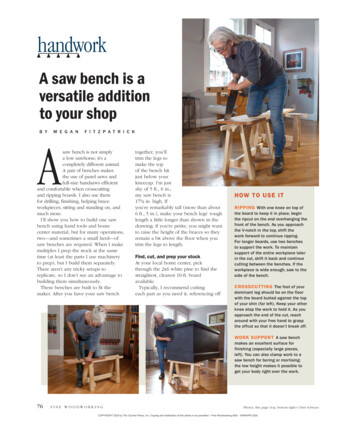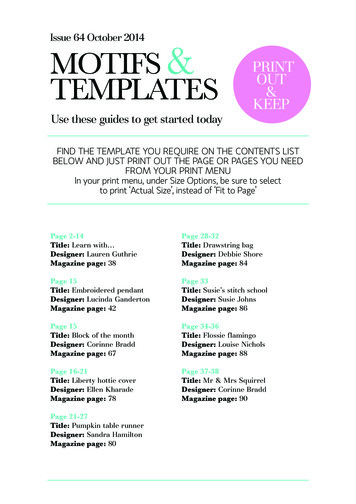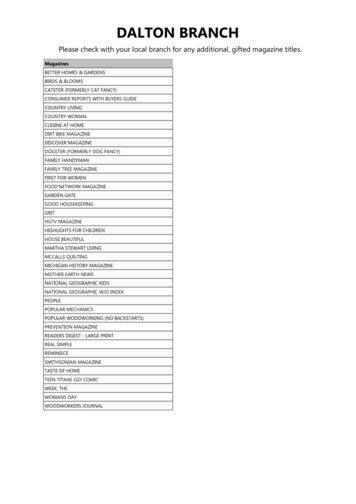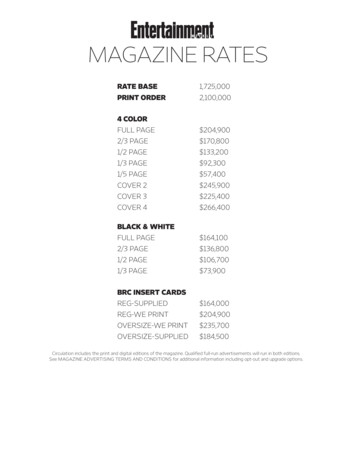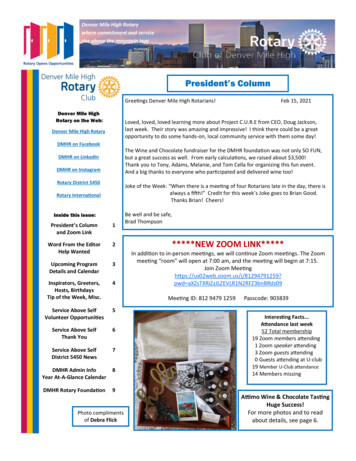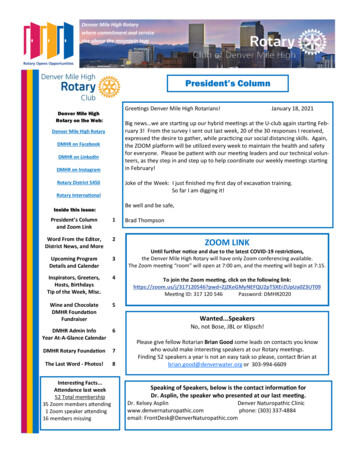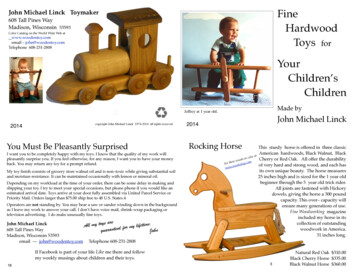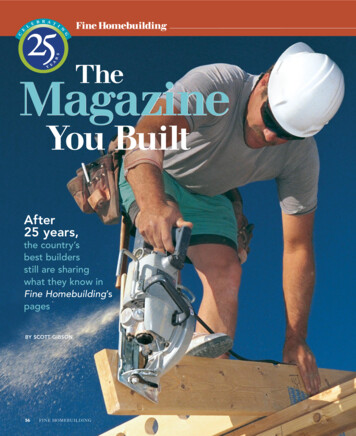
Transcription
Fine Homebuilding TheMagazineYou BuiltAfter25 years,the country’sbest buildersstill are sharingwhat they know inFine Homebuilding’spagesBY SCOTT GIBSON56FINE HOMEBUILDING
FEBRUARY/MARCH 2006“He wanted the articles to come from experts in the field,not from a bunch of freelance writers and deskbound editors.”To Charles Miller, the small ad running in FineWoodworking’s May 1980 issue must haveseemed prophetic. On page 34 was a call fora “homebuilding journalist” to join a magazine that did not yet exist in a publishing field that reallydidn’t exist, either. But the San Francisco Area renovator,illustrator, photographer, and architecture student knewit had been written for him.Elsewhere in the same issue, an announcement fromFine Woodworking founder and publisher Paul Romanfilled in the details: “Just as a void existed for the seriouswoodworker when we started Fine Woodworking magazine five years ago,” Roman wrote, “so does a void existfor the serious homebuilder and renovator today. Thereis no magazine that covers the whole broad and vitalfield of homebuilding with quality, style and depth. Sowe at The Taunton Press are starting a magazine this fall that will dojust that, and we’re calling it FineHomebuilding, because that’s what itwill be about.”Five years earlier, Roman and hiswife, Jan, had launched Fine Woodworking on a shoestring, and by 1980,it was clear their model for producingreader-written magazines could work.Their approach hinged on findingpeople like Miller, who not only wasknowledgeable about the trade but alsocould become a capable journalist. Soon,he had been named western editor, andearly in the new year, the first issue of FineHomebuilding appeared on newsstands.Issue No. 1, February/March 1981, was68 pages, with eight pages of advertising and a murkycover photograph of someone at work inside an old house(photo right). On the back cover was a description of howan Inuit named Tookillkee Tiquktak built igloos (bottomphoto, p. 61). A subscription cost 14.That was 25 years, 177 issues, and a lot of history ago,but Miller was right about at least one thing. The admight as well have been written just for him; he’s still onthe masthead. More important, Paul Roman was rightabout something, too. Readers would welcome a magazine that seriously covered the craft of building houses.Photo facing page: Bruce GreenlawOf course, the Romans and Miller weren’t perfectlyclairvoyant. They might have miscalculated on onedetail. But we’ll get to that later.Getting articles from builders rather thanwriters made a big differenceIt was Paul Roman’s frustration over the lack ofinformation about home building years earlier thatcould be marked as the magazine’s real beginning.The Romans had moved to Newtown, Conn., in 1973,and Paul Roman acted as general contractor for the construction of their new house. He took on some of thework himself, but when he sought magazines and booksfor help, he didn’t find much. Magazines of the day, hesays, didn’t cover construction in any detail, and one ofthe few books he found useful hadbeen published in the 1930s.“The amazing thing to me wasthe lack of information out there asto how do you build a house,” he says.“There was really no information.”And with Fine Woodworking booming, he adds, “it was just logicalto me, ‘Hey, let’s do a homebuilding magazine.’ ”Building houses was a new topic,but the magazine was to use thesame guiding principles that hadlaunched Fine Woodworking. Onewas to limit ads to products related to building, what the company calls endemic advertising.Another was a financial structure putting most of the burden of paying forthe magazine on subscribers, not on advertisers as mostmagazines do, which allowed the company to put readerinterests first.But paramount to the plan was making sure the information the magazine published was authoritative.Roman hired a Vermont renovator, teacher, and fledglingbook author named Mike Litchfield as the first managing editor and put him to work rounding up articulatebuilders willing to write about what they knew.“He wanted the articles to come from experts in thefield, not from a bunch of freelance writers and desk-The right shiny lure.To our great goodfortune, the wantad above, whichappeared in theMay 1980 issue ofFine Woodworking,caught Charles Miller’s attention. Millerwas hired that yearand has worked onevery single issue ofFine Homebuilding.FEBRUARY/MARCH 200657
“We were honoring something we felt strongly about,which was these skills of home building.”How’d they shootthat photo? Froma helicopter, ofcourse. CharlesMiller convincedhis boss that hehad to hire a helicopter, then hadto persuade thepilot to violateFAA regulationsand fly low enoughto get the shot.bound editors,” Litchfield recalls. “He wasreally emphatic about that. He wantedauthenticity. We had envisioned from thebeginning that Fine Homebuilding wouldreally fall more on the side of nuts-and-boltstechnical information, information you coulddo something with.”Litchfield, like every Fine Homebuilding editor who followed him, went on the road. UsingFine Woodworking contacts as a startingpoint and urged on by Roman, he traversedthe country in search of authors and articles. “Basically, he just handed me a creditcard and told me to see what was out thereand develop a national network of contributors,”Litchfield says. “I think the magazine really began, maybe as all magazines begin, with friends of friends.”An article mix that blended design withpractical how-to from prosBack in Newtown, art director Roger Barnes, Roman,and a small group of editors were developing an article matrix, a kind of blueprint for the types of articlesthe magazine would publish. They foresaw a balancebetween new construction and renovation, regular repre-sentation for a variety of building trades, and a good doseof architecture and design.Many of the 13 feature articles in the first issue of themagazine look strikingly familiar today. There weremeat-and-potato articles on basic building techniques,some project-specific narratives, and several articlesabout design. Departments included “Tips & Techniques,” “Q&A,” and “Great Moments”—all of whichhave survived essentially intact. Some of the headlines inthat issue could, in fact, run in today’s Fine Homebuildingwithout raising an eyebrow.But there was something else: an air of scruffy selfsufficiency that seemed unpolished and gritty. One articleexplained how the author used his tractor and an ingenious system of cables and pulleys to raise a timber-frameworkshop by himself. Another covered site-built solarcollectors, a forerunner of many such articles the magazine would publish in the early years.“The original intention was for the magazine to beaimed at people like Paul and Roger who wanted towork on their own houses or even build their own housesfrom scratch,” says John Lively, who took over as editorof the magazine with its seventh issue and retired last fallas Taunton’s CEO. “So they tried to create articles morearound owner-building.”It was also a magazine of its time. Energy shortagesloomed over the economy. Both the Vietnam War and thepolitical upheavals of the 1970s were still raw memories.A lot of people now wanted to build their own houses orat least know how it was supposed to be done.“I think the ’60s and ’70s spawned an appreciation forhandmade stuff,” Miller says. “It was as though the Artsand Crafts era, William Morris and all, had returned ina way. And I think part of it was a turning away fromcorporate America, a very conscious, ‘I’m not going to belike my dad, I’m going to work with my hands—at leastuntil they get arthritis.’ ”A staff of builder-writers helps to keep it realBudweiser andbeer nuts. Mostshelter magazinessend a photographer, a stylist, and asemi full of props tophotograph a house.Fine Homebuildingsends one editor(often a former carpenter) who stylesthe photos as besthe can.Yet the magazine was about the craft of building houses,not a manifesto for social change, and carpenters with alove for language made ideal editors as well as authors.“We were literally making it up as we went along, butall in a very good way,” says Paul Spring, a builder whobecame a Fine Homebuilding editor in 1981. “I think theexcitement for the readers, for the editors, and certainlyfor me was the feeling that we were honoring somethingwe felt strongly about, which was these skills of home“Most photos published in the magazine still are taken58FINE HOMEBUILDINGTop photo: Charles Miller. Bottom photo: Rich Ziegner.
Are those hard hatsfake? They’re real,but we cloned themin with Photoshopbefore first publishing these photos in2001. We had hireda local photographerfor an article oncrane safety. Whenwe saw that none ofthe crew was wearing head protection,we nearly had topull the article. Oneobservant readerwrote to scold us.building. I didn’t know of another magazine that didthis. My work as a builder had been published in othermagazines, but they didn’t want to know who built it.They weren’t interested in the techniques. They wantedto know the designer or architect.”Spring was far from the last builder to be hired as aneditor. Two chief editors—Mark Feirer and now KevinIreton—were carpenters before they were magazine editors, and much of the current staff of editors once workedin the trades. Career journalists are still a rarity here.The strategy is not without its risks, but when editorswho once were builders sat down to work on articlesabout building, there was an unexpectedly rich reward.“I think we all had to rewrite these builder-writtenarticles to some extent,” says Spring. “But there wasalmost a religious responsibility to maintain the tone andthe authenticity of the manuscript. We called up everyauthor with our changes, and we negotiated them. Thebest compliment we could get was, ‘Boy, you didn’t changemy article much at all!’ All the editors were aware thatthey could completely rewrite something, absolutely gut it,and that readers wouldn’t know. But it wouldn’t be the rightthing to do, and in fact the article would not be as good.”(Spring holds the record, having once spent more than fivehours on the phone discussing changes with an author.)The process is the same today. Editors look for potentialauthors among the ranks of carpenters, plumbers, elec-tricians, and architects, then take their manuscripts andturn them into articles. And authors still get at least thechance to argue against changes in their manuscripts.Who’s this magazine for, anyway?From the beginning, articles have covered a diverse rangeof building topics, everything from plumbing a toilet todesigning an addition. The information was, and is, forpeople who do things, not for armchair quarterbacks.What wasn’t as clear was whether articles were writtenfor professionals or amateurs.The magazine’s original plan was to keep content centered among three constituencies: architects,builders, and homeowners. Authors came fromthe pro ranks. Early conscripts included BobSyvanen, a traditional Cape Cod builder; JudPeake and Don Dunkley, production buildersfrom the West; and a little later, a roof-framingwizard named Scott McBride. They wereall authoritative and dependable. (McBridegot started writing for Fine Homebuildingbecause he had broken both ankles in a falland needed something to occupy his mind.When he came in to talk about his articles,he arrived in a wheelchair.)These and many other well-qualifiedauthors were delivering straight-from-the-What were wethinking? This coverfrom 1983 showstile being installedaround a lowlytoilet flange. Someon the staff thoughtthe image lookedlike an abstractexpressionistpainting. In thosedays, we didn’tworry much aboutnewsstand sales.by staff editors who have not had much formal training.”Top photos: Mike Rogers. Bottom photo: Charles Miller.FEBRUARY/MARCH 200659
“The magazine became part of a broad community of builders, not justIs that guy wearing a Rolex? Westopped worryingabout the quality ofdigital photographywhen a reader wrotein to complain aboutthis 2001 cover. Hesaid no real contractor would wear aRolex. He was rightabout the watch butwrong about thecontractor.field information that wasn’t being publishedanywhere else. But keeping articles interesting enough for pros and still clear enough fornonpros could be challenging. Which groupis more important is a debate that has neverreally ended.Maybe it doesn’t matter. For the 20 yearsIreton has been at the magazine, the past 14as its editor, the ratio of pro to nonpro readers has stayed roughly 50-50. To him, whatmatters most is not numbers but the waythe magazine conveys information.“If we decide to do an article on howto lay a hardwood floor, that’s what wefocus on,” he says. “How do you do this process? It didn’tmatter whether it was a pro or a nonpro who was goingto read it. The question was how do you do this job well?How do you get a quality installation as quickly as possible? We really weren’t thinking, ‘Was this for a pro or anonpro?’ We were thinking about the process itself.”Helping readers who think visuallyAsk a carpenter how to build something, Ireton says, andchances are good he’ll pick up a pencil and start to sketch.Building is a visual business, and both photography andcarefully detailed illustrations have been at the heart ofFine Homebuilding’s content.From the start, editors went on the road with theircameras. Most photos published in the magazine still aretaken by staff editors who have not had much formaltraining but who know exactly what a good photographmust have: relevant information.The work takes camera-toting editors to job sites allover the country and, on at least one memorable occasion, into a helicopter. On one photo shoot, Miller wasin Carmel, Calif., to take pictures of a seaside housedesigned by Charles Green. He convinced his editor, JohnLively, that the best photo would be shot from the air.It sounded like a great idea, but the 500-an-hour pilotrefused to take the aircraft below 1000 ft. At that height,the house was just a blob. Miller cajoled the pilot intoflying lower, but he refused to hover. He made one pass,and Miller shot two rolls of film, 72 frames.When he got the film back, Miller was horrified tosee that each of the 36 frames on the first roll had beenblurred by a combination of helicopter speed and filmtype. He went through the second roll. Every frame wasblurred—until he came to number 37, an extra picturethat shouldn’t have been on the roll. It was in focus andbecame the cover of issue #24 (top photo, p. 58).We have to ski tothe cabin? In 1987,author Bill Phelpsfailed to mentionthat there were noroads to his Wyoming cabin beforeTim Snyder flew outto photograph theplace. In turn, Timfailed to mentionthat he had brokenhis leg in a pickupbasketball game.Despite his brokenleg, Tim skied to thecabin for the photos.60FINE HOMEBUILDINGTop photo: Roe A. Osborn. Bottom photo: Tim Snyder.
a disseminator of information.”“I can remember the feeling on early photo shoots ofbeing an impostor,” says Ireton. “You were given thisequipment and sent out to take photographs. You’darrive at somebody’s house, and they would say, ‘Well,the photographer is here.’ I’m thinking to myself, ‘Yeah,but yesterday I was nailing shingles on a roof in Maine. Idon’t know about photography.’ ”A major change for the magazine and its editors wasthe adoption of digital photography in 2000. Until then,it could be a nail-biting couple of days after an assignment to find out whether the film was any good (sometimes it wasn’t). With a digital camera, an editor knowsinstantly whether the shot is good. There is no film toworry about, and a camera can hold hundreds of coverquality photos.The advantages are many, but some editors weren’t soenthusiastic about the conversion. They worried that thenew format wasn’t capable of showing as much detail asreal film. Those fears more or less went away after issue#142 was published in October 2001. A reader wrote tocomplain that the cover photo showed an author wearinga Rolex wristwatch (top photo, facing page). Had to be amodel in a posed photo, the reader opined, because nobuilder would wear a watch like that on a job site (actually, he was wrong about that). The letter told the magazine two things: Digital photography had plenty of detail,and readers were watching. Really, really carefully.In the end, it’s still about process anda community that loves itBuilding houses today is far different than it was 25 yearsago, and so is the magazine, at least outwardly. When themagazine began, the average house in the United Stateswas 1720 sq. ft. and cost 83,000. By 2004, the average sizewas 2349 sq. ft. and the cost 274,500. This issue of FineHomebuilding runs 176 pages, 83 of them advertising. Aone-year subscription costs 38.The magazine long ago stopped accepting featurearticles about cordwood saunas, solar collectors, andigloos. There are more photos and fewer words, and published houses are inarguably more expensive than ever.Not all readers are happy about that. But the basic tenetsthat have guided the magazine for 25 years— readerwritten articles, subscriber-financed content, endemicadvertising—haven’t changed. In sticking to the plan,Fine Homebuilding makes good money and has a paidcirculation of well over 300,000.And something else happened, too. The magazinebecame part of a broad community of builders, not justa disseminator of information. That was one outcomeof publishing this particular kind of magazine, the oneTop photo: Scott Gibson. Bottom photos: Ulli Steltzer.delightful consequence that neither Miller nor Paul andJan Roman could have completely foreseen.“We were going to an audience who loved doing thework, loved being builders, loved the camaraderie andcommunity and society of a job site, and we were theirnational magazine,” Lively says. “We gave them a placein very much the same way that Fine Woodworking gavewoodworkers a place. Whether pro or amateur, if youare intellectually engaged and emotionally fulfilled by theactivity of building, this magazine’s for you. If all you’reafter is the financial result of the house, it’s not the magazine for you.”Today, Fine Homebuilding’s community is most evidenton the magazine’s Web site reader forum called “Breaktime.” Regulars dole out information, trade wisecracks,and mercilessly jump on the magazine when they thinkthe criticism is deserved (one post last year questioningwhether FHB was dishing up the right content pulled inmore than 150 replies). Breaktimers even use the site toset up “fests” around the country so that they can meetone another. (Aussie Mark Cadioli always gets the prizefor having traveled the farthest at these parties.)“We have a pact with our readers that is justsacred,” Miller says. “The fact that we get paidto do this is cool, but I feel like we’re contributing something.“One time we got a letter from a reader whosaid, ‘You know, I never had that old guy wholived down the street who could show me howto build stuff. Fine Homebuilding is my oldguy.’ And that was touching. Yeah.” Travel expenses:refinishing? Beforedigital photography,editors used Polaroids to previewimages. When shooting this Wisconsincabin, the editorpeeled apart thePolaroid and inadvertently laid thewaste half chemicalside down on anantique table. Thebill for restoring thetable led to one ofthe bigger expensereports we’ve seen.What, no ad? In adeparture from convention, the backcover of issue #1featured the construction of an igloo.For most magazines,the back cover istheir most lucrativead space, but FineHomebuilding stillreserves that spotfor editorial content.Scott Gibson was an editor at Fine Homebuilding for five years during the 1990sand is now a contributing editor.FEBRUARY/MARCH 200661
And with Fine Woodworking boom-ing, he adds, “it was just logical to me, ‘Hey, let’s do a home-building magazine.’ ” Building houses was a new topic, but the magazine was to use the same guiding principles that had launched Fine Woodworking. One was to limit ads to products


